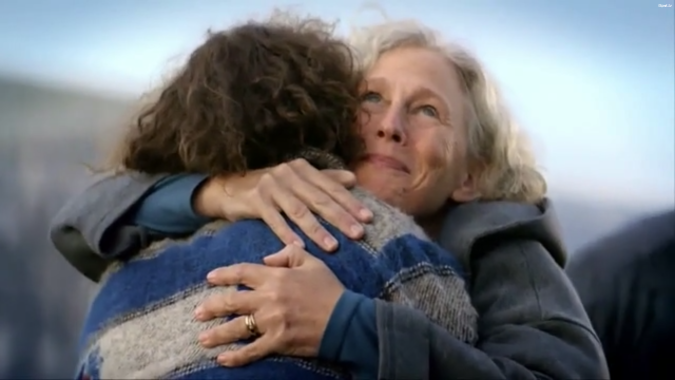As oncology drugs save or extend the lives of many more patients than anyone could have imagined a few years ago, a new challenge has emerged in the wake of their approval: Selling them to patients scared about their prognosis and alternately ignorant of and skeptical about recent breakthroughs in treatment.
Does the current wave of oncology commercials address these and other concerns? Has the creative kept pace with the science? To answer these questions, we took a critical look at four high-profile direct-to-consumer spots for oncology drugs.
1 It’s TRU: Donna’s Story — Living Longer is Possible
 |
 |
Merck’s hook for its most recent Keytruda spots is the simplest one imaginable: It substitutes an actor portraying a patient for a patient portraying a patient. Welcome, one and all, to pharma’s boldest foray into cinéma vérité, once the exclusive domain of scruffy auteurs.
Donna’s Story has a conventional, familiar appeal. It’s shot in tasteful black and white. Its patient testimonial sounds the usual refrains — “I was not ready to give up” and “I used to take the small things for granted; I don’t anymore.” The ad is set in the context of a typical patient day, complete with carpool, workplace, and family breakfast scenes.
Donna’s Story doesn’t provoke much in the way of a reaction. By putting a real non-small cell lung cancer patient through the usual actor-fake patient paces, the spot neutralizes its central premise. The reality of this patient’s life may be warm moments around the kitchen table and no significant interruption at her job. The reality of most patients’ lives is likely different. A less burnished depiction would have better served the brand.
See also: Pfizer bolsters Eucrisa launch with two DTC campaigns
2 Julie’s New Normal
 |
 |
Given its title, you’ll be gobsmacked to learn Pfizer’s most recent spot for metastatic breast cancer drug Ibrance depicts an actor-patient going about her business in much the same manner as she would if unafflicted by cancer. I know, right?
Like Donna’s Story, Julie’s New Normal rehashes the same images we see time and time again in commercials for oncology, autoimmune, and metabolic drugs. The protagonist begins the day by letting the dog out, grabbing the newspaper, and glancing happily at the sky above. Later in the day, she interacts with her students, attends a breast cancer support group, and frolics in the yard with her husband and dog. Need I tell you the spot features a family moment at the kitchen table?
Julie’s New Normal plays it safe while wearing a concussion-resistant crash helmet, wrapped head-to-toe in bubble wrap. The ultimate effect is to focus attention on everything but the subject at hand. It seems inevitable anyone who views more than a handful of these ads in a compressed time frame will start to concentrate less on the risk information than on the homogeneity of setting.
3 A Chance to Live Longer
 |
 |
Opdivo’s recent spots have been vaguely Trumpian. One, humbly titled Most Prescribed Immunotherapy, projected the brand’s name onto the sides of buildings, an execution that brought to mind the approach of the alien destroyers in Independence Day. This probably wasn’t the association team Opdivo hoped viewers would make.
For A Chance to Live Longer, Bristol-Myers Squibb (BMS) assumes a rhetorical stance: Why wouldn’t non-small cell lung cancer patients ask to be treated with Opdivo? Failing to do so would deprive them of the opportunity to give and receive hugs, not to mention stage elaborate family picnics.
See also: AMA votes to require disclosure of drug prices in DTC ads
The message — give Opdivo a shot — resonates. The mashup of family scenes doesn’t do much to further it, though. Scenes of grandpa fishing with junior while dad looks on happily are well and good, but it’s overkill to juxtapose them with ones of patient granny bending to receive a running hug from little Suzie and another of the doctor gesturing toward a computer screen with the Opdivo logo and the words “demonstrated longer life versus chemotherapy.”
Still, kudos to BMS for the spot’s closing text, which acknowledges the roles played by patients, clinicians, and nurses during Opdivo’s clinical trials.
4 Rather Be Home
 |
 |
Amgen’s Neulasta Onpro is a different sell than most other oncology products in that its central feature relates as much to convenience as to efficacy: an on-body injector that administers medicine to patients a day after a grueling chemotherapy session, thus allowing them to skip a return visit to the doctor’s office and the heightened risk of infection that comes with it. Smartly, Rather Be Home takes that hook and runs with it.
The spot devotes itself to the twin comforts of home and companionship, with the patient and her companion luxuriating in the warmth of their family room and backyard. At the same time, Rather Be Home does not shy away from showing the Onpro port, which appears front and center for a solid 10 to 15 seconds — though ultimately, it’s covered up by a shawl. Similarly, the actor-patient appears haggard to an extent that patients in pharma ads usually aren’t. I’m sure a lot of effort went into calibrating the actor’s physical appearance, but still: I bought it.
Does the ad lapse into cliché? Of course, courtesy of cameos by the family dog and the ubiquitous “rustic” backyard swing. But there’s an easy intimacy between the actors and minimal sugarcoating of the day-after distress. That elevates Rather Be Home above the rest of the oncology-ad pack.
From the March 01, 2018 Issue of MM+M - Medical Marketing and Media








